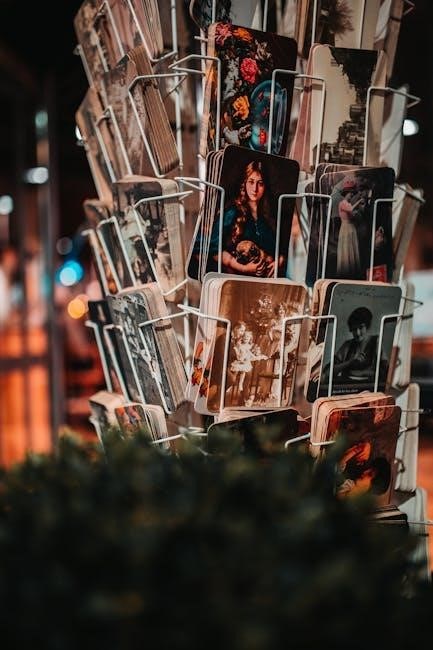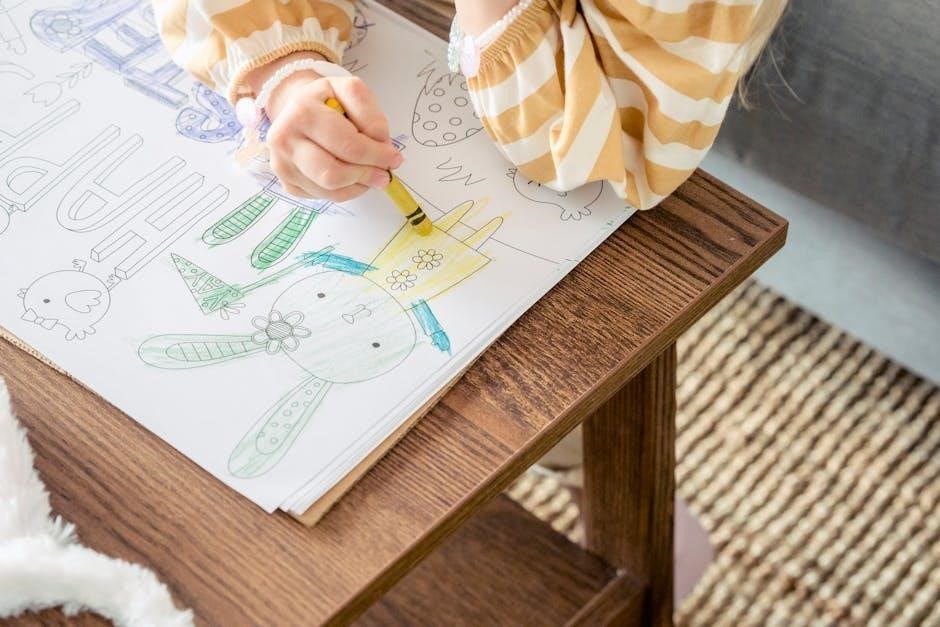Aphasia is a language disorder affecting communication, often caused by brain damage. Picture cards serve as vital visual aids, helping individuals express thoughts and needs effectively.
Understanding Aphasia and Its Impact on Communication
Aphasia is a language disorder arising from brain damage, often affecting individuals’ ability to speak, read, write, and understand language. It commonly results from strokes, traumatic brain injuries, or neurological diseases. The condition varies in severity, with some individuals struggling to find the right words, while others may speak fluently but with limited meaning. Aphasia does not affect intelligence but significantly impacts daily interactions, causing frustration and isolation. Caregivers and families play a crucial role in supporting communication by using visual aids like picture cards, which help bridge the gap between intent and expression. These tools enable individuals with aphasia to convey their needs and thoughts more effectively, fostering independence and confidence in their daily lives.
The Role of Visual Aids in Aphasia Therapy
Visual aids, such as picture cards, play a pivotal role in aphasia therapy by providing individuals with an alternative method of communication. These tools help bypass language barriers, enabling individuals to express their thoughts and needs more effectively. Picture cards are particularly beneficial as they offer clear, tangible representations of objects, actions, and concepts. They reduce stress and frustration during interactions, making communication more manageable. Additionally, picture cards can be customized to suit individual needs, ensuring relevance and effectiveness in therapy sessions. By incorporating these visual aids, therapists and caregivers can create a supportive environment that encourages language recovery and enhances overall quality of life for those with aphasia.
Benefits of Using Picture Cards for Aphasia
Picture cards offer numerous benefits for individuals with aphasia, enhancing their ability to communicate effectively. These tools provide a non-verbal means of expression, reducing frustration and stress during interactions. They are particularly helpful for those with severe speech difficulties, allowing them to convey needs, wants, and ideas through clear visual representations. Picture cards also promote independence, enabling users to participate in conversations without reliance on others. Additionally, they are versatile, suitable for use in various settings such as therapy sessions, daily activities, and social interactions. Their simplicity and accessibility make them an invaluable resource for fostering communication and supporting language recovery in individuals with aphasia.

Types of Aphasia Picture Cards
Aphasia picture cards include naming cards, scene description cards, and multi-language support cards, offering diverse communication tools for individuals with aphasia to express their thoughts effectively.
Naming and Identification Cards
Naming and identification cards are essential tools for individuals with aphasia, featuring images and words to aid in recognizing and naming objects. These cards are widely used in therapy to help recover language skills and improve communication. Often available as free PDF downloads, they provide accessible resources for therapists and caregivers. The cards typically depict common items, such as animals, household objects, or food, accompanied by their names. This visual and textual combination supports individuals in relearning vocabulary and associating words with images. Many sets are categorized by themes, making them versatile for targeted exercises. For example, a card might display a picture of a cat with the word “cat” written below it. These cards are durable when laminated and can be used in various settings, from clinical therapy to home practice, fostering independence and confidence in communication.
Scene Description Cards for Contextual Communication
Scene description cards are designed to depict complex scenarios, such as everyday activities or familiar environments, to facilitate contextual communication. These cards often feature detailed images of settings like parks, kitchens, or workplaces, allowing individuals with aphasia to describe events or situations. By using visual cues, users can practice storytelling, sequencing, and expressive language skills. Many resources offer free PDF downloads of these cards, making them accessible for therapists and caregivers. The scenes are typically high-quality images with clear, recognizable elements, enabling users to point to and identify objects or actions within the context. This approach helps bridge the gap between single-word communication and more complex, narrative expression, fostering engagement and confidence in daily interactions. These cards are particularly effective in group therapy or home-based exercises, promoting meaningful and functional communication.
Multi-Language Support in Aphasia Picture Cards
Multilingual aphasia picture cards are essential for diverse populations, offering text in multiple languages alongside images. This feature ensures accessibility for individuals from various linguistic backgrounds. Many free PDF resources include translations, reducing language barriers and enhancing communication. For example, cards might display words in English, Spanish, and French, aiding therapists and caregivers in multilingual settings. This inclusivity supports global use, making rehabilitation tools widely available. The Aphasia Institute’s ParticiPics database offers such multilingual support, ensuring that individuals worldwide can benefit from visual aids. This approach promotes equality in therapy and daily interactions, empowering users to communicate effectively regardless of their native language. Multilingual cards are a vital resource for fostering inclusive and effective communication strategies.

Creating Your Own Aphasia Picture Cards
Designing custom picture cards involves clear images and simple text, tailored to individual needs. Use free PDF templates for easy printing and customization, enhancing communication support.
Designing Effective Visual Aids for Communication
Designing effective visual aids for aphasia involves using clear, high-contrast images with minimal background clutter. Simple, relevant visuals help individuals focus and understand the message. Adding short labels or phrases in large, easy-to-read fonts enhances comprehension. Organizing images in logical groups or categories can also aid memory and retrieval. Colors should be used sparingly to avoid overwhelming the user. Ensuring that the visuals are culturally appropriate and relatable is crucial for effective communication. Additionally, incorporating multi-language support can make the aids accessible to a broader audience. Regular testing and feedback from users can refine the design, ensuring it meets their needs and preferences. This approach maximizes the effectiveness of visual aids in therapy and daily interactions for individuals with aphasia.
Printing and Laminating Tips for Durability
For lasting use, print aphasia picture cards on high-quality paper or cardstock using a reliable printer. Ensure images are high-resolution and colors are vibrant for clarity. Laminate the cards using a thermal laminator to protect them from wear and tear. Avoid air pockets during lamination for a smooth finish. Organize the cards in a binder or on a ring for easy access. Consider labeling categories or themes on the back for quick identification. Store them in a protective case when not in use to prevent damage. Regularly check for fading or damage and reprint as needed. Durable cards ensure long-term usability in therapy and daily communication, making them a practical resource for individuals with aphasia.
Customizing Cards for Individual Needs
Customizing aphasia picture cards to meet individual needs enhances their effectiveness. Start by selecting relevant images and text that align with the person’s interests, daily routines, and communication goals. Use design software to modify or combine images, ensuring clarity and simplicity. Add personalized photos or symbols to make the cards more meaningful. Incorporate multi-language support if needed, allowing for broader understanding. Organize the cards into categories, such as food, family, or activities, for easier navigation. Involve the individual in the customization process to ensure their preferences are reflected. This personalized approach fosters engagement and independence, making communication more natural and effective. Regularly update the cards as needs evolve to maintain relevance and support ongoing progress.

Communication Boards and Their Importance
Communication boards empower individuals with aphasia to express needs by pointing to pictures, fostering independence and bridging gaps in verbal communication effectively.

How Communication Boards Facilitate Expression
Communication boards are powerful tools that enable individuals with aphasia to express their thoughts and needs through visual symbols or pictures. By pointing to images or words, users can convey messages effectively, even when verbal communication is challenging. These boards provide a structured and accessible means of interaction, reducing frustration and promoting independence. They are particularly useful for those who cannot speak or have limited language abilities. Speech therapists often create customized boards tailored to the individual’s needs, incorporating relevant vocabulary and scenarios. Free PDF resources, such as picture cards and pre-designed templates, are widely available online, making it easier to build and personalize these boards. This visual support not only aids in communication but also supports language recovery and confidence in expressing ideas;
Steps to Build a Personalized Communication Board
Building a personalized communication board involves several key steps. First, assess the individual’s needs, preferences, and frequently used phrases. Next, gather relevant images or symbols, such as free aphasia picture cards, to represent key concepts. Organize the layout logically, grouping similar items together for easy navigation. Add multi-language support if needed to accommodate diverse users. Incorporate a search bar or indexing system for quick access to specific images. Laminate the board for durability and longevity. Finally, test the board with the user, making adjustments based on their feedback. This tailored approach ensures the board is functional, empowering, and aligned with the individual’s communication goals.
Using Picture Cards in Communication Boards
Picture cards are a cornerstone of communication boards, enabling individuals with aphasia to convey thoughts and needs effectively. These cards, often downloaded as free PDFs, provide clear visual cues, aiding language recovery and daily interactions. By laminating and arranging them on a board, users can point to images to express desires, reducing frustration. Multi-language support enhances accessibility, while customizable options ensure relevance to individual preferences. Integration into therapy sessions and everyday routines fosters independence, making communication boards indispensable tools for empowerment. The versatility of picture cards in communication boards bridges gaps, offering a practical solution for effective expression and understanding.

Free Aphasia Picture Card Resources
Free aphasia picture cards in PDF format are widely available online, offering visual aids for communication and therapy. Websites provide downloadable resources, including multi-language support and customizable options.
Top Websites Offering Free PDF Downloads
Several websites provide free PDF downloads of aphasia picture cards, offering a wide range of visual aids for communication and therapy. The Aphasia Institute’s ParticiPics database is a popular resource, featuring a searchable library of pictographic images and customizable templates. Lingraphica also offers free communication boards with vocabulary focused on basic needs and medical interactions. Additionally, websites like UNC’s aphasia-friendly materials and specialized speech therapy platforms provide downloadable resources, including naming cards, scene descriptions, and multi-language support. These tools are designed to reduce communication barriers, aiding individuals with aphasia in expressing their thoughts and needs effectively. They are invaluable for therapists, caregivers, and individuals seeking accessible and practical solutions.
Accessing the Aphasia Institute’s ParticiPics Database
The Aphasia Institute’s ParticiPics Database is a free, searchable library of pictographic images and templates designed to support communication and therapy. To access the database, users are required to provide their first name and email address, after which the resources are emailed as downloadable PDFs. This database offers a wide variety of visual aids, including naming cards, scene descriptions, and multi-language support, making it a valuable tool for therapists and caregivers. The materials are customizable, allowing users to tailor them to individual needs. By leveraging these resources, individuals with aphasia can enhance their communication abilities and engage more effectively in daily interactions. The ParticiPics Database is a cornerstone of accessible and practical support for aphasia therapy.
Downloading and Organizing Free Resources
Downloading and organizing free aphasia picture cards is straightforward and efficient. Most websites offering these resources provide direct links to PDF files, which can be easily downloaded and saved. Once downloaded, organizing the cards into categorized folders, such as by themes or usage frequency, enhances accessibility. Printing and laminating the cards ensures durability for repeated use. Additionally, creating a digital backup or cloud storage ensures that resources are readily available across devices. Proper organization helps therapists and caregivers quickly locate specific cards, streamlining therapy sessions and daily communication support. This systematic approach maximizes the effectiveness of these visual aids in aiding individuals with aphasia.

Therapeutic Activities Using Picture Cards
Picture cards aid in various therapeutic activities, such as naming exercises, memory games, and descriptive tasks, enhancing language recovery and communication skills in individuals with aphasia.
Naming and Descriptive Exercises
Naming and descriptive exercises are fundamental in aphasia therapy, leveraging picture cards to stimulate word retrieval and language expression. These activities involve identifying objects, animals, or scenes, fostering vocabulary recall and confidence. Patients are often asked to describe attributes like color, shape, or function, enhancing semantic processing. Free PDF resources provide diverse visuals, making exercises engaging and adaptable to individual needs. Multi-language support further ensures accessibility for diverse populations. Customizable cards allow therapists to tailor exercises, addressing specific deficits and promoting progress. Regular practice with these tools helps bridge communication gaps, supporting meaningful interactions and overall recovery.

Memory and Matching Games
Memory and matching games using aphasia picture cards are effective tools for stimulating cognitive recovery and language recall. These activities involve matching identical cards or identifying pairs, enhancing memory retention and attention. Patients can use free PDF downloads featuring diverse visuals, such as objects, animals, or scenes, to create engaging exercises. Multi-language support in these resources ensures accessibility for a broader audience. Matching games also promote problem-solving skills and concentration, which are vital for aphasia recovery. Additionally, incorporating memory exercises with picture cards helps rebuild neural pathways, supporting both language and cognitive rehabilitation. This approach not only aids in recalling words but also strengthens overall communication abilities, making it a valuable therapeutic strategy. Laminating cards ensures durability for repeated use, and customizable options allow therapists to tailor games to individual needs, fostering progress and independence. These activities are particularly beneficial when integrated into daily therapy sessions, providing a structured yet enjoyable way to practice and improve communication skills. By leveraging visual aids, memory and matching games offer a practical and effective method for addressing aphasia-related challenges. They also encourage patient engagement and motivation, which are essential for long-term recovery and adaptation to communication barriers.
Incorporating Picture Cards into Daily Therapy Sessions
Incorporating picture cards into daily therapy sessions provides a structured and engaging way to support language recovery. These visual aids can be used for naming exercises, storytelling, and sentence construction, helping individuals with aphasia rebuild communication skills. Free PDF resources offer a wide range of images, from everyday objects to complex scenes, allowing therapists to tailor activities to individual needs. For example, using picture cards to sequence events or describe scenes can enhance narrative abilities. Additionally, pairing cards with memory games or matching exercises reinforces learning and retention. Regular use of picture cards in therapy sessions fosters consistency, boosting confidence and encouraging active participation. This approach not only aids in language rehabilitation but also provides a sense of accomplishment, motivating individuals to continue their progress.

Supporting Communication in Daily Life
Picture cards enhance daily communication by providing visual support, reducing frustration, and fostering independence. They aid in expressing needs, telling stories, and engaging in conversations effectively.
Strategies for Caregivers and Family Members
Caregivers and family members play a crucial role in supporting individuals with aphasia. Using picture cards as visual aids can significantly enhance communication, making interactions clearer and less frustrating. Encourage the use of these cards in daily conversations to help express needs, wants, and ideas. Create a communication-friendly environment by displaying cards in accessible locations. Be patient and allow time for responses, speaking clearly and using simple language. Incorporate the cards into routines, such as meal planning or scheduling, to foster independence. Additionally, consider laminating cards for durability and organizing them by category for easy access. Multi-language support in picture cards can also aid in bridging communication gaps. By consistently using these tools, caregivers can empower individuals with aphasia to communicate more effectively and confidently.
Using Picture Cards in Various Settings
Picture cards are versatile tools that can be used in numerous settings to support individuals with aphasia. In clinical environments, they aid speech therapists during therapy sessions, helping patients practice naming and descriptive exercises. At home, caregivers can incorporate these cards into daily routines, such as meal planning or scheduling, to facilitate clear communication. They are also effective in medical settings, where they can reduce stress and ensure patients’ needs are understood. Additionally, picture cards can be used in community spaces, such as stores or restaurants, to help individuals with aphasia navigate everyday interactions. Their portability and simplicity make them invaluable across various contexts, enhancing independence and confidence in communication.
Encouraging Independence Through Visual Aids
Visual aids like picture cards empower individuals with aphasia to communicate independently, reducing reliance on others. These tools enable self-expression, fostering confidence and autonomy in daily interactions. By using customizable picture cards, individuals can convey their needs, preferences, and thoughts clearly. Portability is a key advantage, allowing these aids to be used in various settings, from home to public spaces. Free PDF resources, such as the Aphasia Institute’s ParticiPics database, provide accessible materials that can be tailored to individual needs. Encouraging the use of these visual aids helps individuals with aphasia maintain their independence and participate fully in life, promoting a sense of control and dignity in their communication journey.
Aphasia picture cards are invaluable tools for communication and therapy. Explore free PDF resources and continue creating personalized aids to support ongoing recovery and independence.
Summarizing the Value of Aphasia Picture Cards

Aphasia picture cards are essential tools for enhancing communication and therapy. They provide visual support, aiding individuals in expressing thoughts and needs effectively. These cards facilitate memory recall, simplify complex ideas, and offer multi-language options, making them accessible to diverse users. Free PDF downloads enable easy access and customization, allowing therapists and caregivers to tailor activities to individual needs. Printed and laminated cards ensure durability for repeated use. By incorporating these aids into daily interactions and therapy sessions, individuals with aphasia can achieve greater independence and confidence in communication. Their versatility in various settings underscores their importance as a practical and effective resource for language recovery and daily interaction.
Exploring Additional Resources and Tools
Beyond picture cards, numerous online platforms offer comprehensive resources for aphasia support. Websites like the Aphasia Institute provide databases of pictographic images, while others offer free worksheets and communication board templates. Apps designed for AAC (Augmentative and Alternative Communication) also include customizable picture symbols and speech-generating devices. Educational platforms and speech therapy sites provide downloadable materials, such as naming exercises and memory games. These tools complement picture cards, offering diverse methods to enhance communication and therapy. Exploring these resources can provide caregivers and therapists with a wide range of options to tailor activities to individual needs, fostering independence and language recovery in individuals with aphasia.
Motivation to Continue Using and Creating Visual Aids
Using and creating visual aids like aphasia picture cards fosters independence and confidence in individuals with aphasia. Seeing progress in communication and daily interactions motivates continued use. The availability of free resources, such as downloadable PDFs and customizable templates, makes it easier to stay engaged. Encouragement from caregivers and therapists plays a key role in maintaining momentum. Witnessing improved expression and understanding can be incredibly rewarding, reinforcing the value of these tools. By embracing creativity and consistency, individuals and their supporters can overcome challenges and achieve meaningful communication goals, making the effort worthwhile and inspiring further progress.
